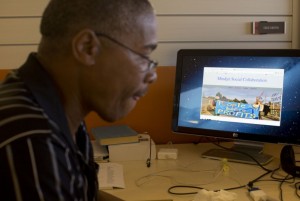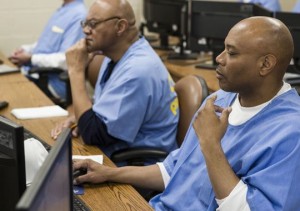By Hamed Aleaziz Photo: TIM HUSSIN / Special To The Chronicle

Web developer Eddie Griffin just finished an internship at a tech company and is on the hunt for a new position. But his background sets him apart from many of Silicon Valley’s programmers.
Just over a year ago, the 58-year-old Richmond resident was in San Quentin State Prison, serving the 13th year of a 27-to-life prison sentence. He was given a second chance under Proposition 36, the 2012 measure that reformed the state’s “three strikes and you’re out” law, and appears to be making the most of it.
While Griffin’s story is unique, Prop. 36 proponents say it’s emblematic of a wider trend of inmates released under the law faring well, despite arguments that the repeat offenders would be dangerous.
More than 1,900 prisoners have been released under Prop. 36, with the average person out for a little over a year, according to Stanford Law School’s Three Strikes Project. Just 3.5 percent have returned to prison for committing a new crime, state data reviewed by the group shows.
That’s roughly 10 times lower than the rate for all California prisoners released for a similar amount of time, according to Stanford’s analysis.
“You cannot find another group of prisoners who have been released from almost anywhere that have had such a low recidivism rate,” said Michael Romano, who heads the Three Strikes Project and helped write Prop. 36. “I think it really does prove that these sentences were just not effective law enforcement policy.”
Waiting to gauge results
Advocates for crime victims, though, say it’s too soon to draw conclusions about Prop. 36, one of several measures passed in recent years designed to throttle back a tough-on-crime trend that crowded California’s prisons.
“Two years since Proposition 36 has passed is not nearly enough time to gauge recidivism rates. … Let’s put these guys on the streets for three years and see how they fare,” said Marc Klaas, whose 12-year-old daughter Polly’s murder at the hands of a career criminal led to passage of the three-strikes law in 1994.
The landmark measure put violent criminals behind bars for at least 25 years to life after a third felony conviction. But Prop. 36 exempted offenders whose third strike wasn’t defined as violent or serious, qualifying about 3,000 inmates for release or resentencing — as long as they successfully petitioned the courts.
Mark Zahner, who heads the California District Attorneys Association, an organization that opposed Prop. 36, acknowledged that people released under the law have had a lower return-to-prison rate than other offenders. But he said some of those released have returned to county jails, and he agreed it is too early to draw conclusions.
The Stanford researchers do not have data on total arrests involving the released prisoners, which are not collected by the state.
The debate is likely to heighten with Tuesday’s passage of Proposition 47 on the state ballot. It reduced certain lower-level felonies to misdemeanors, including most drug possession cases and crimes such as forgery and theft of goods worth less than $950. And it could free more three-strikes inmates.
Romano said about 800 inmates who applied for resentencing under Prop. 36 are awaiting court decisions, while more than 150 have been denied. The law says courts can continue to hold a three-strikes prisoner found to pose an “unreasonable risk of danger to public safety.”
Specific violent crimes
That phrase was undefined under Prop. 36. But under Prop. 47, it now means the court must believe a prisoner is likely to commit specific crimes such as homicide or sexual assault. The new definition could help those in the petition process, Romano said, as well as those who were previously denied.
Zahner said he is concerned. “So we won’t have murderers and rapists roaming the streets,” he said, “but we will have carjackers, armed robbers and arsonists.”
Romano said the early data on three-strikes releases show such fears are misplaced.
“Our basic assumptions about recidivism risk were just wrong,” he said. “People can be released from prison safely and, given appropriate support, successfully reintegrate with their families and communities.”
Sentence for crack cocaine
Romano points to Griffin, a Navy veteran who moved to the Bay Area from his native Detroit in the mid-1970s and settled in San Jose, as an example of what is possible.
While Griffin’s future appears wide open, his past was anything but. Between 1990 and 2013, he spent about three months outside prison.
According to legal filings by Santa Clara County prosecutors, who opposed Griffin’s release under Prop. 36, he has eight felony convictions. He picked up one strike for beating and robbing a prostitution customer in a motel, prosecutors said, and another strike for robbing a man and throwing him out of a car.
But the big blow came in 2000, when he was sentenced to 27 years to life after being found with a couple dozen rocks of crack cocaine.
“When I first received the sentence, it didn’t totally sink in, because I just felt that, you know, I mean I possessed some drugs, and you’re going to end my life because I possessed some drugs? That was really hard to take,” he said.
During his final prison term, Griffin took college courses. He went to Alcoholics Anonymous along with Narcotics Anonymous to deal with a cocaine addiction, and he helped start Criminals and Gangsters Anonymous. He taught other inmates how to read.
“My thing was, if I’m going to die in prison, what’s going to be my legacy?” he said.
Griffin enrolled in the Last Mile program at San Quentin, started by two Silicon Valley venture capitalists, where he learned about technology, social media and how to start a business — even though prisoners didn’t have access to computers.
Griffin was freed by Prop. 36 on July 30, 2013. Prosecutors sought to block his release, citing his “abysmal criminal history,” but his public defender said he had “tried to take advantage of all opportunities to better himself as a person and gain insight into his past mistakes.”
Internship extended
Griffin was released in downtown San Jose. He’d never held a smartphone or used a computer. So for three months, he studied CSS and HTML at a veterans center in San Jose.
Next came a three-month internship with Mindjet, a software firm in San Francisco that had supported the Last Mile program. That turned into a nine-month stay. His boss, Austin Walne, said the company extended the internship because of Griffin’s “great work ethic, strong progress and positive attitude.”
“I’ve picked up quite a bit,” Griffin said. “This is a tremendous opportunity. … I still don’t get a lot, but there’s a lot that I do understand. It gives me a better idea of what it’s going to take for me to move forward to be a better programmer or working in the tech field, period.”
‘I have to pay them back’
Since his internship ended in late September, Griffin has been training with a few San Francisco tech startups and has interviewed for other jobs.
Romano said it’s difficult to explain what is behind the low recidivism rate, other than that many three-strikes prisoners are older and weren’t as dangerous as their long prison terms suggested. Re-entry services, which the Stanford group coordinated, also probably helped, he said.
“There’s also something to the fact that the government and the voters of California have said this was unfair, and you deserve to be out,” he said.
Sitting in Mindjet’s offices in September, Griffin said California voters should be rewarded for passing Prop. 36.
“So this is how I have to pay them back,” he said. “I have to do what I am supposed to do, get a job, pay taxes. It’s kind of like my duty to be a stand-up guy.”
Hamed Aleaziz is a San Francisco Chronicle staff writer. E-mail: haleaziz@sfchronicle.com Twitter: @haleaziz
Photo :Griffin works on coding at Mindjet, a San Francis<130>co software firm that supports a program that provides technological training to former inmates entering the workforce.<252>


















